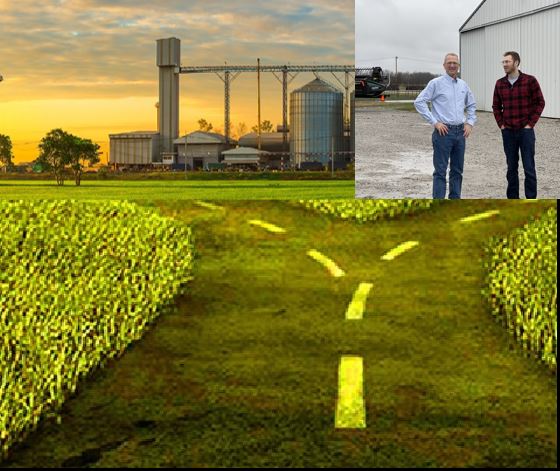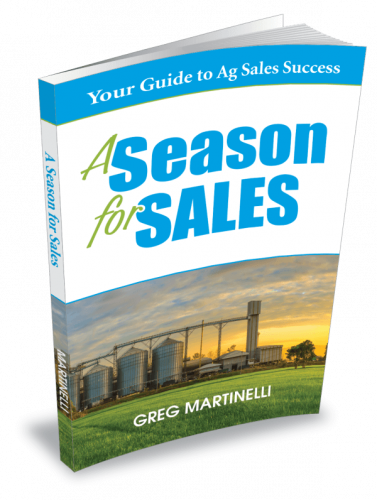And what is your role as their salesperson when they do?
Your farmer customers are struggling to stay afloat right now, more than probably ever in their farming history. Unless they farmed through the 1980’s, right now is their most difficult time.
This means their decision-making process is equally the most difficult and most important in their farming history. The impact of a bad decision can be fatal to their farm. When times are good and everyone is making money, they can withstand a bad decision, maybe even losing a few dollars per acre.
But right now the stakes are high every time they decide what to plant….when to lock in their crop inputs….when to market their grain or livestock…..
I compare it to walking across a 2 X 6 board. If you lay that board on the ground, most of us could walk across those 8 feet of board with no problem. However, if you raise that board 100 feet in the air, you just increased the risk and pressure of making a mistake. One wrong move can cost you your life. You will think twice about every move you make up there. You would really want someone you trust to help you walk that short walk. Well, right now, your farmer customers are on that board, 100 feet above the ground.
Your role as their salesperson or more importantly, their trusted advisor has never been more important. As unhappy as our farmer customers might be towards us and our prices, always remember that they are looking for you to help get them through this tough time.
As their trusted advisor, we have to set aside the negativity and continuously strive to be a resource for them. We have to keep them moving. And to move, they have to make decisions.
Here are 4 thoughts on a farmer’s decision-making that can help you to help them:
- Avoiding bad decisions versus making good decisions:
Most people are more afraid of making a bad decision than they are excited about making a great decision. Said another way, most people are more afraid of failure than they are excited about success. This thought process can lead farmers to wait and wait before making a decision. It’s almost a paralysis type scenario. Both choices seem risky, so they just don’t make any decision. There is another mental component to this type of struggle. It’s called FOMO: Fear of missing out. Farmers are so afraid of missing out on higher grain markets or lower crop inputs/feed prices that they can’t pull the trigger and buy from you or sell you grain. I’m sure every producer has sold grain below the highest price. They feel terrible for missing out on another 30 cents a bushel. So, again, they sit in this FOMO state, which is a decision paralysis stage.
2. Safe vs Speculative decisions: “Nobody ever got fired for buying IBM”
That old saying about IBM points out that in a risky world, farmers are going to stick to what they know. When computers weren’t at the quality they are today, the rule was that IBM’s might be more expensive, but nobody was going to blame you for buying the trusted brand. In farming, this means farmers will make the safe decision, which is what everyone else is doing. Safety in numbers. If everyone is doing it, then it must be a good choice. Ag tech products struggle with this situation the most. When you show up on the farm with a new way of feeding out cattle or increasing corn yields, the farmer thinks about how his dad did it or may stick with the tried & true method they have always done. They see your research data which shows increased average daily gain or an increase of 5 bushels per acre. However, they don’t buy it because they know the current results they are getting and it’s “working”. If this is happening, then apply the next concept to help them make decisions/changes.
3. Apply DISC to help your customers make better decisions
DISC of course is the four-quadrant analysis that you really need to be aware of when selling. Each quadrant has different approaches to making decisions.
Here are some critical thoughts for each quadrant:
- D is for Dominance type personality. They love control and results. To help them make decisions, offer them more choices and bring them realistic results that can be achieved.
- I is for Influence type personality. They love the most innovative big picture option you have. Details bore them. So, bring them forward thinking positive concepts when helping them decide. This group can have a tendency to be rash in their decisions. Jumping in and out of new prodcuts and services so fast it might be hard to determine what worked and what didn’t. With several of my customers that were this type, I was the offsetting person in their decision process. That really helped me move into the role as their trusted advisor versus just selling them something.
- S is for Steadiness type personality. This might be the toughest person to work with on making decisions. They truly need a lot of trust and relationship support to make decisions. They avoid change as it might upset the people in their life. Their decisions are easier if there are guarantees or a way to go back to the old tried & true ways. They also like to test anything new before jumping in with all of their acres or livestock. Offer to test it on one hog barn or one of their fields before jumping all in. You might also offer to meet with the other people in their life to help make a decision.
- C is for Conscientious type personality. They love details, analysis and being able to do their own research. You can’t give this person too much information to make a decision. Their biggest fear is making a mistake because they acted too fast before they could thoroughly analyze their options. If you have an ROI calculation for your product, show it to them and then ask them to pick it apart. I guarantee they will have their twist on how accurate it is.
4. Coaching your customer
As a salesperson, your superpower strength is that you go farm to farm to farm all day and every day. You see what works and what doesn’t work. While you can’t name drop unless you have permission, you can use the knowledge you gain to help guide your farmers to make better decisions.
The GROW coaching model is one of the easiest to learn and use with customers.
GROW Coaching Model:
G- Goal: Where are you trying to go in your farming business?
R- Reality: Where are you currently at?
O- Options: What are the various routes to go from where you are to where you want to go?
W- What: What’s the next step or series of steps?
As farmers make their daily decisions, bring your knowledge and these four decision-making concepts to help them make the most challenging decisions for their farm!


